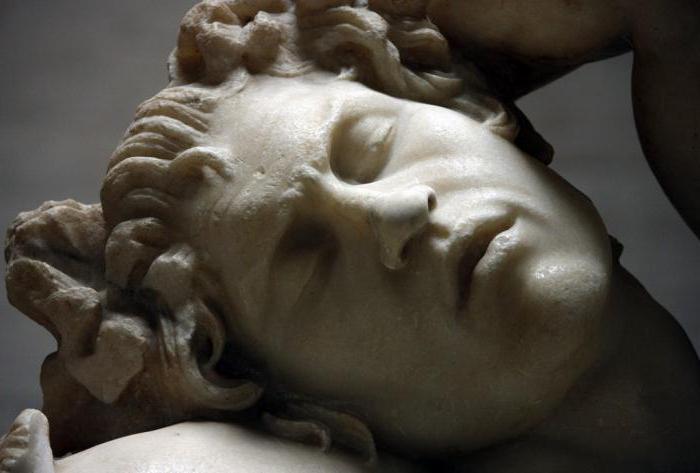The Munich Glipothek from 1804 began to collect sculptures, reliefs, mosaics that date from the archaic period until the time of late Rome. Her collection includes classic Hellenistic artifacts, Roman sculptures, and ancient works in their heyday. Among the latter, one of the prominent places is the “Faun Barberini” or “The Drunk Satyr,” as it is also called.
Where was the sculpture created?
In the years 283-133 BC. e. in Asia Minor, near the shores of the Aegean, there was a powerful capital called Pergamum. The art of architects and sculptors flourished in it. The Romans conquered the city and the kingdom of the same name, making it their province. Everything that seemed to them the most valuable, they were taken to Rome. Among other things, there was a figure of a sleeping drunk faun, as the Romans called the satyrs, created around 220 BC Where they placed it is not known, but it is known exactly where and when it was found.
Location
Under the onslaught of the barbarians, by the four hundredth year Rome weakened. Everything was used to strengthen the city. Including sculptures. "Faun Barberini", the perfect creation of unknown masters from Pergamum, did not escape this fate. In the 1620s, he was found near the place where the castle of the Holy Angel is now. German art critic Winkelman suggested that the statue belonged to Emperor Hadrian, a fan of gay, which in those days was very close to normal. "Faun Barberini" extremely openly demonstrates its genitals, and therefore it was found near the mausoleum of the emperor.
Where did the satyr go
The pious Barberini family handed over the faun to the collection of Pope Urban VIII, who came from the Barberini family and to whom Francesco Barberini was an uncle. Secular authorities in Europe refused to reckon with the pontiff. His moral authority was below all criticism. Such a frank sculpture as the “Faun Barberini” only had a place in the personal collection of the pope. The whole family and the pontiff actively sponsored the arts. For example, they supported the outstanding sculptor and architect D. Bernini, the creator of the new Baroque style. Since the satyr had numerous injuries and his expressive obscene pose brought him closer to the aesthetics of the baroque, it was believed that Bernini himself partially restored it. In the following centuries, many sculptors worked on its restoration.
Repurchase of the statue and its copies
Before Napoleon's second invasion of Italy in 1799, his younger brother was asked to acquire satire. A legal scandal erupted over the export of the statue. Canova particularly protested. Contrary to the ban, the Faun Barberini was sold to Germany. There was already being built a glypothek, in which he had found a place of honor.
Numerous copies were made from the statue. The marble statue of the Hellenistic era became very popular. In the Louvre there is a high-quality copy of it, which was made by the sculptor E. Bouchardon. She found a place in Russia. The Peterhof Grand Cascade gives zest to a gilded statue of a faun in a grotto.
Satyr came from Greek mythology. This forest deity is apparently very ancient. Then the Hellenes animated all objects: stones, trees, animals, that is, shamanism flourished among them. Faun was associated with fertility in the broadest sense, and therefore a huge phallus is its important affiliation. Bearded, hairy, goat-footed, always drunk and lustful, they chased nymphs and maenads. Norms of morality for them did not exist. Their attributes were tiers, flute and leather wineskins. The statue of a sleeping satyr is not at all like a faun.
Roman deity
The supportive and kind faun is an Italian deity who adopted the features of the Greek god Pan. Faun - mountain, forest and field spirit, responsible for the fertility of fields and people. This forest god loves to settle in caves near streams, keys - the sources of all kinds of water. The Romans adopted the humanoid image of the faun from the Greeks, where all the deities were anthropomorphic.
Sculpture of barberini
Their faun is depicted as a man, which is already a deviation from the norm. He obviously went over the wine at the feast. But the faun is still not a person: a tail peeps out from behind his left thigh.
The statue is very significant not only as a work of art, but also because it dates back two centuries before the birth of Christ. Perhaps this is the Greek original, or maybe a later Roman copy. These points are always difficult to determine. The statue was badly damaged. I had to restore the right leg and foot, the lower part of the left thigh. The sculpture is extremely erotic, perhaps that is why many sought to buy a faun. His legs are apart, he is in a drunken drowsiness. It seems that he is tired to the limit. At the same time, the body of the faun is somewhat tense.

The face of the faun is very sensual, the head with horns is rejected. The sculptor thoroughly studied human anatomy and worked out muscles, shoulders, and stomach. The sculptor turned his whole body slightly, complicating his work. Ultimate naturalism, emotional state, the study of the human body - these are the tasks that stood before the sculptor. He put the figure of the faun on the skin of a leopard, put the heel of the faun on it and rolled it under his head for a better rest. This marble statue has all the signs of a work of the Hellenistic era.